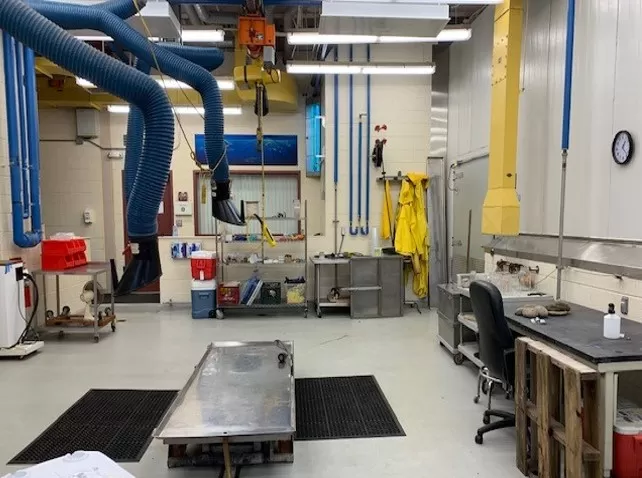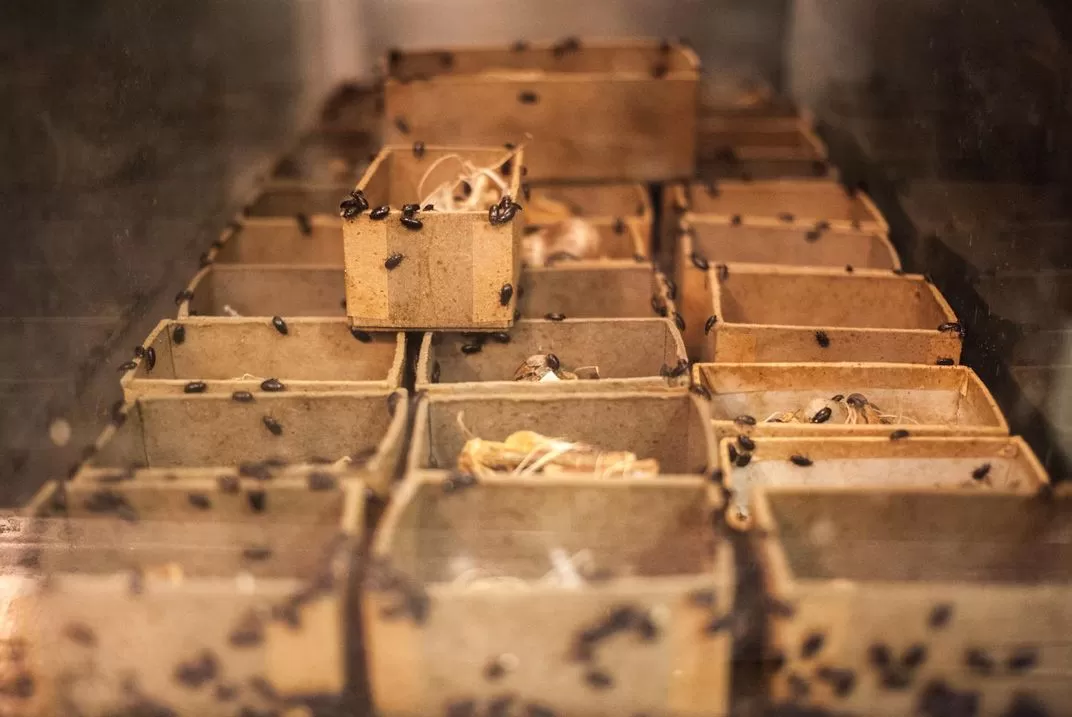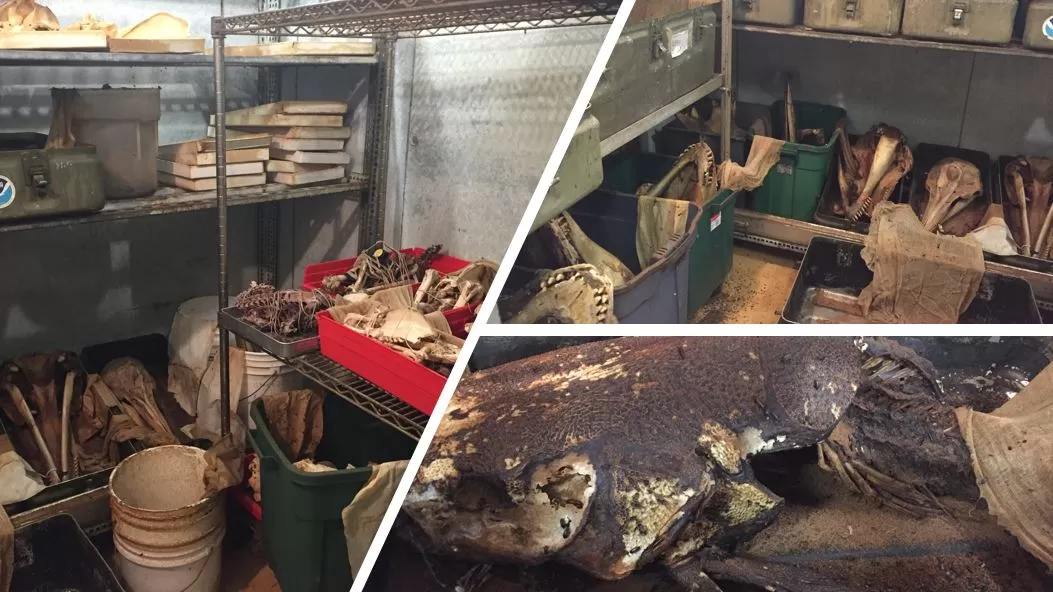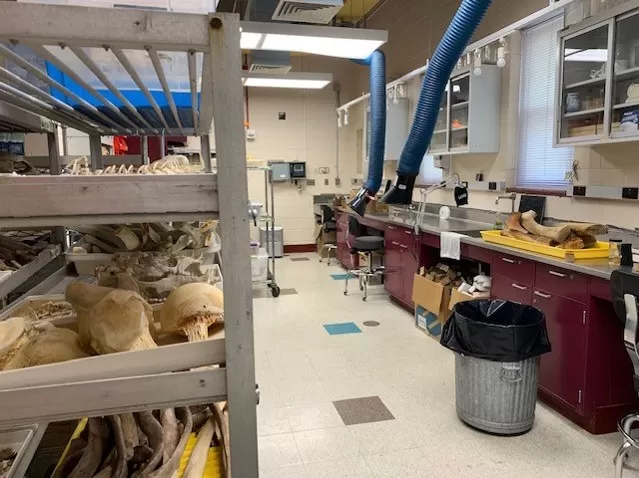
Search
MSC: Osteology Prep Lab
The Smithsonian’s Osteo Prep Lab (OPL) is used to prepare specimens for the National Museum of Natural History, perform necropsies, and serves as long-term storage for a small amount of frozen collections.
Skeletal remains arrive at OPL from several sources:
- Remains are collected during fieldwork from animals that have perished in their natural habitat. Those remains are sent to the OPL from a global network of museum curators, technicians, and affiliates.
- The Smithsonian National Zoo sends exhibit specimens that have recently died of natural causes.
- On occasion, OPL may accept specimens for processing from external government agencies or other private institutions.
The preparation and curation procedures of vertebrate specimens relies on the commitment of the OPL staff, as well as the use of dermestid colonies, composting and other maceration techniques. Visiting scientists studying vertebrate anatomy use the lab’s sizeable space and state-of-the-art necropsy equipment for large-animal dissections on a regular basis. In addition, the OPL is integrally involved in tissue collection from animal remains, which are held by the museum for research purposes in both collections spaces at the museum and our unique biorepository at the Museum Support Center. OPL staff may also preserve research skins or produce fluid specimens by request from VZ departments. The osteology specimens in the museum’s research collections draw scientists from around the world, and the research done on the specimens has resulted in many intriguing discoveries.
Osteo Prep Lab Structure
Smithsonian’s OPL features several crucial lab spaces, including the necropsy lab, environmental suite, processing lab, and external courtyard spaces.
Necropsy Lab

The building was constructed in 1994 and features a state-of-the-art necropsy lab. The necropsy lab is outfitted for necropsies (examination and dissection of an animal after death) and preparation of many kinds of specimens. This lab includes a large central space for preparing specimen skins and roughing out skeletons. Common tools and implements include a hydraulic necropsy table, 2-ton hoist, bone saws, table saw, elephant trunk exhaust fans, and various other sharps. The necropsy lab contains both a large -20°C walk-in freezer and a 0°C “cold room” to dry out specimens prior to their introduction to the beetle colonies.
Dermestid Beetle Colonies
OPL’s large climate-controlled chambers for our dermestid beetle colonies are central to the lab’s mission. Our dermestids are housed in two 9x9’ walk-in Bally boxes heated to between 81-85°F and kept at a relative humidity of 70%. The bug chambers are kept isolated from the rest of the Museum Support Center and in darkness, with bedding for the larvae to pupate. Osteo prep labs use dermestid beetles to clean animal skeletons, a tradition that dates back to the late 1800s. Dermestid beetles have a number of advantages over other osteological prep methods. They eat the tissue from specimens in a fraction of the time (a colony can clean off a small mammal in just a few hours, and larger specimens in a matter of days). They are significantly less messy than other methods. Moreover, they are much less harmful to the bones themselves.

Of course, preparing specimens for a trip to the beetle tank is not pretty. Each specimen has to be tagged, skinned, gutted, and dried. This process both cuts down on the likelihood of rot and mold, and makes the soft tissue more fragrant, to better attract bugs. Dermestids are the unsung heroes of natural history museums—as long as they do not escape! Also part of the environmental suite is a large fume hood that OPL staff use to fix (preserve) specimens with formalin to create fluid specimens.


Processing Lab
Last, but certainly not least, is the OPL’s processing lab. The processing lab is where OPL staff finish cleaning specimens after exposure to the beetles. Cleaning specimens is a several step process that must occur before any OPL specimens are added to research collections or sent to the National Museum of Natural History. The process includes soaking specimens in ammonia and “picking” specimens clean of any lingering soft tissues. Some departments require further de-greasing and such specimens are soaked in various organic solvents. After a final ammonia soak, OPL staff place specimens on open metro carts in two drying rooms to dry. Specimens are then verified in an inventory and then packed for transport. This processing lab space also features basic tools for construction of boxes, drilling holes in tags, and a packing station to securely wrap and ship specimens.
Extant Spaces
In addition to these crucial lab spaces, the Smithsonian’s OPL also features a large wrap-around courtyard that contains our two 9x9’ auxiliary freezers, a composting site, ample space for maceration tanks, and a storage shed. These spaces are secured by a white security fence to both prevent carrion scavengers and so not to perturb other Smithsonian employees.
